The Intel Skylake i7-6700K Overclocking Performance Mini-Test to 4.8 GHz
by Ian Cutress on August 28, 2015 2:30 PM ESTCPU Tests on Windows: Professional
Cinebench R15
Cinebench is a benchmark based around Cinema 4D, and is fairly well known among enthusiasts for stressing the CPU for a provided workload. Results are given as a score, where higher is better.

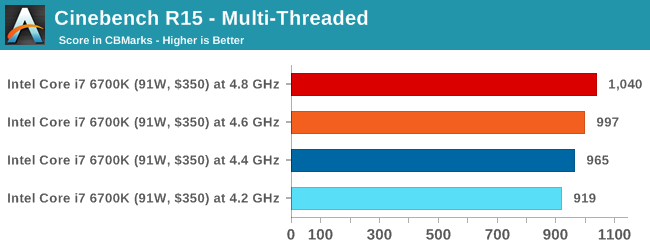
Agisoft Photoscan – 2D to 3D Image Manipulation: link
Agisoft Photoscan creates 3D models from 2D images, a process which is very computationally expensive. The algorithm is split into four distinct phases, and different phases of the model reconstruction require either fast memory, fast IPC, more cores, or even OpenCL compute devices to hand. Agisoft supplied us with a special version of the software to script the process, where we take 50 images of a stately home and convert it into a medium quality model. This benchmark typically takes around 15-20 minutes on a high end PC on the CPU alone, with GPUs reducing the time.
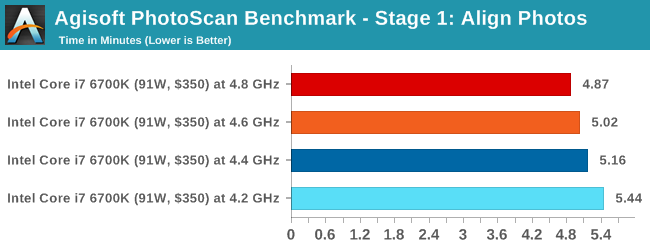
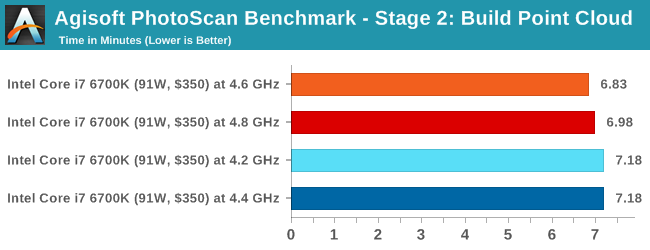
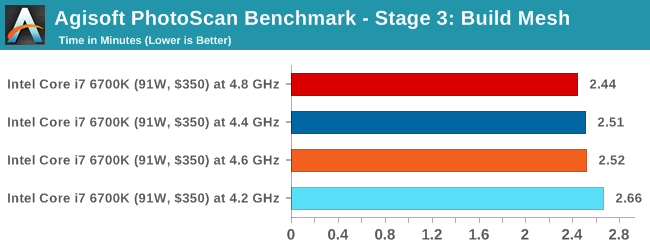
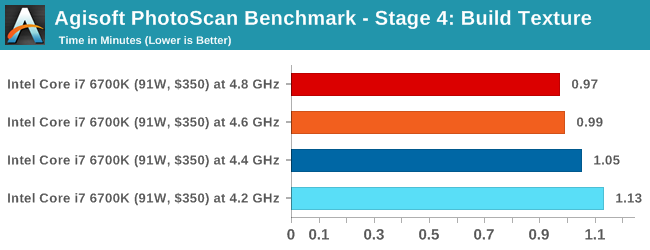
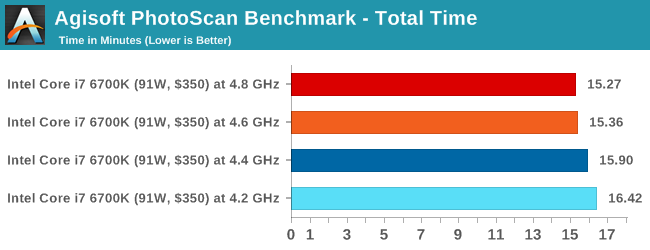
Rendering – PovRay 3.7: link
The Persistence of Vision RayTracer, or PovRay, is a freeware package for as the name suggests, ray tracing. It is a pure renderer, rather than modeling software, but the latest beta version contains a handy benchmark for stressing all processing threads on a platform. We have been using this test in motherboard reviews to test memory stability at various CPU speeds to good effect – if it passes the test, the IMC in the CPU is stable for a given CPU speed. As a CPU test, it runs for approximately 2-3 minutes on high end platforms.
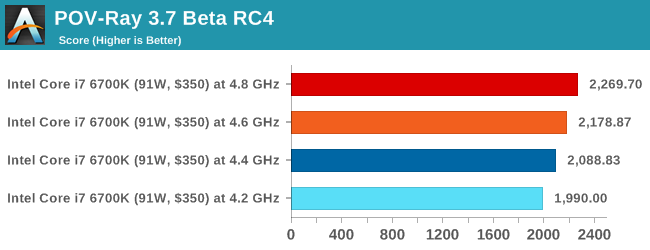
HandBrake v0.9.9 LQ: link
For HandBrake, we take a 2h20 640x266 DVD rip and convert it to the x264 format in an MP4 container. Results are given in terms of the frames per second processed, and HandBrake uses as many threads as possible.
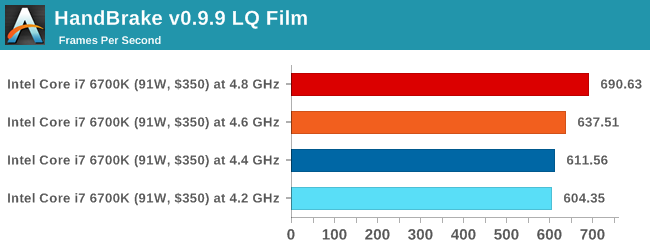
Conclusions on Professional Performance
In all of our professional level tests, the gain from the overclock is pretty much as expected. Photoscan sometimes offers a differing perspective, but this is partly due to some of the randomness of the implementation code between runs but also it affords a variable thread load depending on which stage. Not published here are the HandBrake results running at high quality (double 4K), because it actually failed at 4.6 GHz and above. There is a separate page addressing this stability issue at the end of this mini-review.










103 Comments
View All Comments
Oxford Guy - Tuesday, September 1, 2015 - link
(says the guy with a name like Communism)HollyDOL - Sunday, August 30, 2015 - link
Well, you might have a point with something here. Even though eye itself can take information very fast and optical nerve itself can transmit them very fast, the electro-chemical bridge (Na-K bridge) between them needs "very long" time before it stabilises chemical levels to be able to transmit another impulse between two nerves. Afaic it takes about 100ms to get the levels back (though I currently have no literature to back that value up) so the next impulse can be transmitted. I suspect there are multitudes of lanes so they are being cycled to get better "frame rate" and other goodies that make it up (tunnel effect for example - narrow field of vision to get more frames with same bandwidth?)...Actually I would like to see a science based article on that topic that would make things straight on this play field. Maybe AT could make an article (together with some opthalmologist/neurologist) to clear that up?
Communism - Monday, August 31, 2015 - link
All latencies between the input and the output directly to the brain add up.Any deviation on top of that is an error rate that is added on top of that.
Your argument might as well be "Light between the monitor and your retina is very fast traveling, so why would it matter?"
One must take everything into consideration when talking about latency and temporal error.
qasdfdsaq - Wednesday, September 2, 2015 - link
Not to mention, even the best monitors have more than 2ms variance in response time depending on what colours they're showing.Nfarce - Sunday, August 30, 2015 - link
As one who has been building gaming rigs and overclocking since the Celeron 300->450MHz days of the late 1990s, I'd +1 that. Over the past 15+ years, every new build I did with a new chipset (about every 2-3 years) has shown a diminished return in overclock performance for gaming. And my resolutions have increased over that period as well, further putting more demand on the GPU than CPU (going from 1280x1024 in 1998 to 1600x1200 in 2001 to 1920x1080 in 2007 to 2560x1440p in 2013). So here I am today with an i5 4690K which has successfully been gamed on at 4.7GHz, yet I'm only running it at stock speed because there is ZERO improvement on frames in my benchmarked games (Witcher III, BF4, Crysis 3, Alien Isolation, Project Cars, DiRT Rally). It's just a waste of power and heat and wear and tear. I will overclock it however when running video editing software and other CPU-intensive apps which noticeably helps.TallestJon96 - Friday, August 28, 2015 - link
Scalling seems pretty good, I'd love to see analysis on the i5-6600k as well.vegemeister - Friday, August 28, 2015 - link
Not stable for all possible inputs == not stable. And *especially* not stable when problematic inputs are present in production software that actually does something useful.Beaver M. - Saturday, August 29, 2015 - link
Exactly. Fact of the matter is that proper overclocking takes a LONG LONG time to get stable, unless you get extremely lucky. I sometimes spend months to get it stable. Even when testing with Prime95 like theres no tomorrow, it still wont prove that the system is 100% stable. You also have to test games for hours for several days and of course other applications. But you cant really play games 24/7, so it takes quite some time.sonny73n - Sunday, August 30, 2015 - link
If you have all power saving features disabled, you only have to worry about stability under load. Otherwise, as CPU voltage and frequency fluctuate depend on each application, it maybe a pain. Also most mobos have issues with RAM together with CPU OCed to certain point.V900 - Saturday, August 29, 2015 - link
Thats an extremely theoretical definition of "production software".No professional or production company would ever overclock their machines to begin with.
For the hobbyist overclocker who on a rare occasion needs to encode something in 4K60, the problem is solved by clicking a button in his settings and rebooting.
I really don't see the big deal here.